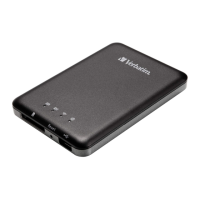
Do you have a question about the Verbatim 98243 and is the answer not in the manual?
Lists the key features and capabilities of the Wi-Fi SD/USB device, including storage support and streaming.
Specifies the physical size of the Wi-Fi SD/USB device in millimeters.
Details the technical specifications including CPU, Wi-Fi standards, USB interface, and battery capacity.
Defines the normal and non-operating temperature ranges for the device's operation.
Explains the function of the micro USB port for data transfer and charging the internal battery.
Describes the USB 2.0 host interface for connecting mass storage devices and charging mobile gadgets.
Details the SD slot compatibility and adapter requirements for various SD card types.
Covers the functionality of the power button for switching the device on/off and the reset button.
Explains the meaning of different colors and blinking patterns for the Power and Wi-Fi LEDs.
Provides step-by-step instructions on how to insert an SD memory card into the device.
Guides on connecting USB mass storage devices, like flash drives, to the device's USB port.
Steps to connect the Wi-Fi SD/USB device to a PC wirelessly via Wi-Fi network.
Instructions on launching and using the AirStor software to find and access the connected device.
Guide on configuring the device settings through the PC's web management interface using AirStor.
Steps to download and install the AirStor app on iOS devices from the App Store.
Instructions for establishing a wireless connection between the device and an iPhone or iPad.
Details on logging into the AirStor app on iOS devices using administrative credentials.
Steps to download and install the AirStor app on Android devices from the Play Store.
Instructions for establishing a wireless connection between the device and an Android device.
Explains the main screen interface and navigation within the AirStor app on iOS devices.
Describes the main screen interface and navigation for the AirStor app on Android devices.
How to play music or audio files stored on the device using the app on both iOS and Android.
Instructions for playing movie and video files on iOS devices via the AirStor application.
Guide on viewing and playing photo files on iOS devices using the AirStor application.
Guide on viewing and playing photo files on Android devices using the AirStor application.
Options for sharing photos from the device via email, album, or Facebook on iOS.
Options for sharing photos from the device via email, album, or social media on Android.
How to open and view various document file types like PDF, DOC, and PPT on iOS devices.
How to open and view various document file types on Android devices using supported viewers.
Details on performing file operations like copy, delete, download, and upload using the app.
Steps to copy or transfer files from the device to the local storage of mobile devices.
Steps to copy or transfer files from mobile devices to the device's Wi-Fi storage.
Instructions for easily deleting single or multiple files from the device or mobile storage.
How to check the status and history of file upload and download operations on the device.
Procedures for closing the AirStor application on iOS devices by returning to the home screen.
Procedures for closing the AirStor application on Android devices by selecting the exit option.
Steps to remove the AirStor application from iOS devices by deleting the app icon.
Steps to remove the AirStor application from Android devices via the application manager.
Describes the web-based file browser for managing files and folders on the device.
Details the pop-up menu options available for file and folder manipulation in the web interface.
Explains the drag-and-drop functionality for transferring files within the web interface.
Provides comprehensive details about the device's hardware, storage, and network status.
Access point for configuring various system parameters including admin user and disk information.
Configuration options for hostname, Wi-Fi, LAN, DHCP, Internet, and DDNS.
Options for enabling network services like Windows File Sharing for data access.
Configuration of time settings, backup, firmware upgrade, and factory reset for the device.
